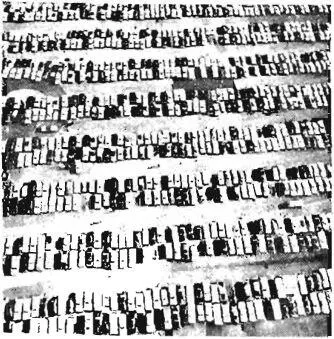Christopher alexander - A pattern language
Здесь есть возможность читать онлайн «Christopher alexander - A pattern language» весь текст электронной книги совершенно бесплатно (целиком полную версию без сокращений). В некоторых случаях можно слушать аудио, скачать через торрент в формате fb2 и присутствует краткое содержание. Жанр: Прочая научная литература, на английском языке. Описание произведения, (предисловие) а так же отзывы посетителей доступны на портале библиотеки ЛибКат.
- Название:A pattern language
- Автор:
- Жанр:
- Год:неизвестен
- ISBN:нет данных
- Рейтинг книги:3 / 5. Голосов: 1
-
Избранное:Добавить в избранное
- Отзывы:
-
Ваша оценка:
- 60
- 1
- 2
- 3
- 4
- 5
A pattern language: краткое содержание, описание и аннотация
Предлагаем к чтению аннотацию, описание, краткое содержание или предисловие (зависит от того, что написал сам автор книги «A pattern language»). Если вы не нашли необходимую информацию о книге — напишите в комментариях, мы постараемся отыскать её.
A pattern language — читать онлайн бесплатно полную книгу (весь текст) целиком
Ниже представлен текст книги, разбитый по страницам. Система сохранения места последней прочитанной страницы, позволяет с удобством читать онлайн бесплатно книгу «A pattern language», без необходимости каждый раз заново искать на чём Вы остановились. Поставьте закладку, и сможете в любой момент перейти на страницу, на которой закончили чтение.
Интервал:
Закладка:
 |
| The destruction of human scale. |
504
103 SMALL PARKING LOTS
open space around them. They make people feel dominated by cars; they separate people from the pleasure and convenience of being near their cars; and, if they are large enough to contain unpredictable traffic, they are dangerous for children, since children inevitably play in parking lots.
The problems stem essentially from the fact that a car is so much bigger than a person. Large parking lots, suited for the cars, have all the wrong properties for people. They are too wide; they contain too much pavement; they have no place to linger. In fact, we have noticed that people speed up when they are walking through large parking lots to get out of them as fast as possible.
It is hard to pin down the exact size at which parking lots become too big. Our observations suggest that parking lots for four cars are still essentially pedestrian and human in character; that lots for six cars are acceptable; but that any area near a parking lot which holds eight cars is already clearly identifiable as “car dominated territory.”
This may be connected with the well-known perceptual facts about the number seven. A collection of less than five to seven objects can be grasped as one thing, and the objects in it can be grasped as individuals. A collection of more than five to seven things is perceived as “many things.” (See G. Miller, “The Magical Number Seven, Plus or Minus Two: Some Limits on Our Capacity for Processing Information,” in D. Beardslee and M. Wertheimer, eds., Readings in Perception, New York, 1958, esp. p. 103.) It may be true that the impression of a “sea of cars” first comes into being with about seven cars.

The small lots can be quite loosely placed.
Metropolitan regions will not come to balance until each one is small and autonomous enough to be an independent sphere of culture.
There are four separate arguments which have led us to this conclusion: I. The nature and limits of human government. 2. Equity among regions in a world community. 3. Regional planning considerations. 4. Support for the intensity and diversity of human cultures.
I. There are natural limits to the size of groups that can govern themselves in a human way. The biologist J. B. S. Haldane has remarked on this in his paper, “On Being the Right Size”:
. . . just as there is a best size for every animal, so the same is true for every human institution. In the Greek type of democracy all the citizens could listen to a series of orators and vote directly on questions of legislation. Hence their philosophers held that a small city was the largest possible democratic state. ... (J. B. S Haldane, “On Being the Right Size,” The World of Mathematics , Vol, 77, J. R. Newman, ed. New York: Simon and Schuster, 1956, pp. 962-67).
It is not hard to see why the government of a region becomes less and less manageable with size. In a population of N persons, there are of the order of N 2person-to-person links needed to keep channels of communication open. Naturally, when N goes beyond a certain limit, the channels of communication needed for democracy and justice and information are simply too clogged, and too complex; bureaucracy overwhelms human processes.
And, of course, as N grows the number of levels in the hierarchy of government increases too. In small countries like Denmark there are so few levels, that any private citizen can have access to the Minister of Education. But this kind of direct access is quite impossible in larger countries like England or the United States.
We believe the limits are reached when the population of a region reaches some 2 to 10 million. Beyond this size, people become remote from the large-scale processes of government. Our estimate may seem extraordinary in the light of modern history: the nation-states have grown mightily and their governments hold power over tens of millions, sometimes hundreds of millions, of people. But these huge powers cannot claim to have a natural size.
11
BUILDINGS
Therefore:
Make parking lots small, serving no more than five to seven cars, each lot surrounded by garden walls, hedges, fences, slopes, and trees, so that from outside the cars are almost invisible. Space these small lots so that they are at least too feet apart.
| five to seven cars |
|---|
 |
«£♦ *$♦
Place entrances and exits of the parking lots in such a way that they fit naturally into the pattern of pedestrian movement and lead directly, without confusion, to the major entrances to individual buildings—circulation realms (98). Shield even these quite modest parking lots with garden walls, and trees, and fences, so that they help to generate the space around them— POSITIVE OUTDOOR SPACE (l06), TREE PLACES ( 171 ), GARDEN WALLS (l73). . • •
506
fix the position of individual buildings on the site, within the complex yone by one yaccording to the nature of the site }the trees, the sun: this is one of the most important moments in the language;
104. SITE REPAIR
105. SOUTH FACING OUTDOORS
106 POSITIVE OUTDOOR SPACE
107 .WINGS OF LIGHT
108. CONNECTED BUILDINGS
109 .LONG THIN HOUSE
507
| 104 SITErepair** |
|---|
 |
. . . the most general aspects of a building complex are established in BUILDINC COMPLEX(95), NUMBER OF STORIES(96), and circulation realms(98). The patterns which follow, and all remaining patterns in the language, concern the design of one single building and its surroundings. This pattern explains the very first action you must take—-the process of repairing the site. Since it tends to identify very particular small areas of any site as promising areas of development, it is greatly supported by building complex(95) which breaks buildings into smaller parts, and therefore makes it possible to tuck them into different corners of the site in the best places.
Buildings must always be built on those parts of the land which are in the worst condition, not the best.
This idea is indeed very simple. But it is the exact opposite of what usually happens; and it takes enormous will power to follow it through.
What usually happens when someone thinks of building on a piece of land? He looks for the best site—where the grass is most beautiful, the trees most healthy, the slope of the land most even, the view most lovely, the soil most fertile—and that is just where he decides to put his house. The same thing happens whether the piece of land is large or small. On a small lot in a town the building goes in the sunniest corner, wherever it is most pleasant. On a hundred acres in the country, the buildings go on the miost pleasant hillside.
It is only human nature; and, for a person ■ who lacks a total view of the ecology of the land, it seems the most obvious and sensible thing to do. If you are going to build a building, “. . . build it in the best possible place.”
Читать дальшеИнтервал:
Закладка:
Похожие книги на «A pattern language»
Представляем Вашему вниманию похожие книги на «A pattern language» списком для выбора. Мы отобрали схожую по названию и смыслу литературу в надежде предоставить читателям больше вариантов отыскать новые, интересные, ещё непрочитанные произведения.
Обсуждение, отзывы о книге «A pattern language» и просто собственные мнения читателей. Оставьте ваши комментарии, напишите, что Вы думаете о произведении, его смысле или главных героях. Укажите что конкретно понравилось, а что нет, и почему Вы так считаете.












